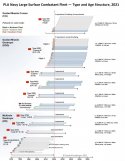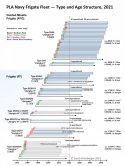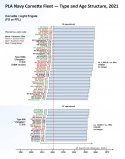Be stingy with your words, and things will work themselves out.The corvette force is ideal for tighter, shallower ocean environments, like China's key areas of concern, the ; around Taiwan; and the Senkaku/Diaoyu islands in the East China Sea, controlled by Tokyo but claimed by Beijing.
The ships the PLAN puts to sea near Chinese shores are protected by a large ground-based missile force.
The missiles "problematize US power projection and prevent overwhelming naval and air power from striking the Chinese mainland," said Kaushal. "However, this also has the effect of facilitating power projection against local nations, as these nations are far more vulnerable when the maritime links that enable the US to support them are severed."
For instance, if the US Navy was unable to operate in the South China Sea because of the Chinese missile threat, it would have a hard time protecting the Philippines, with which Washington has a mutual defense treaty.
US military leaders are also cognizant that in 2021 the PLA Navy is much more than ships.
"Take a look at what China's really investing in," US Chief of Naval Operations Adm. Mike Gilday said this week in . "Yes, they are putting more ships in the water, but they're investing heavily in anti-ship missiles as well as satellite systems to be able to target ships."
All that gives China a strong hand to play in any possible conflict close to home. And China is adamant its military is defensive.
"The development of China's national defense aims to meet its rightful security needs and contribute to the growth of the world's peaceful forces," said the country's 2019 defense white paper, titled "China's National Defense in the New Era."
"China will never threaten any other country or seek any sphere of influence."
So why is the PLA Navy building aircraft carriers, amphibious assault ships and large, powerful destroyers and cruisers suitable for operation far from China?
Near seas defense vs far seas protection
Protecting the Chinese mainland and its territorial claims around the region are what Beijing calls "near seas defense."
China's massive naval buildup coincides with it reinforcing its claims to almost all of the 3.3 million square-kilometer (1.3 million square-mile) South China Sea by building up tiny reefs and sandbars into man-made artificial islands heavily fortified with missiles, runways and weapons systems.
"Islands and reefs in South China Sea have unique advantages in safeguarding national sovereignty and maintaining a military presence in the open sea," read a December 2020 a Beijing-based magazine published by the China State Shipbuilding Corporation, which supplies the PLA Navy.
But they can't stand alone, the magazine noted. In the events of hostilities, outposts in the southern reaches of the waterway could require reinforcements from near China's southern coast, more than a day's sailing away, it said.
o bring Chinese military power to bear on its global interests, they said, China has begun implementing "far seas protection."..
"Far seas protection reflects Beijing's direction for the PLAN to 'go global,' ... part of a larger Chinese government policy to encourage the expansion of China's economy and cultural outreach," Rice and Robb wrote.
Part of the play is perception. For decades now, nothing has quite projected military power as the image of a US Navy aircraft carrier in waters far from home. It's something China craves, analysts say.
"Some Chinese military analysts suggest it is imperative for the PLA to safeguard China's overseas interests and note that sending out the PLAN is essential to establishing China's image as a great power," Rice and Robb wrote.
Dozens of corvettes can't do that. So China has ramped up its production of ships that form an aircraft carrier task force, like guided-missile cruisers and nuclear-powered submarines, which have much longer endurance than the diesel-electrics that comprise most of the PLAN fleet.
The PLA Navy has two aircraft carriers in service, but their endurance without refueling is limited to less than week, according to the China Power project. That makes them more suitable for use in places like the South China Sea rather than in far oceans.
But more carriers are in planning and production. The newest planned Chinese carrier is expected to be equipped with a nuclear power reactor and electromagnetic catapults that will enable it to launch aircraft with more firepower and greater range than the existing carriers.
Rice and Robb point out that two Chinese defense white papers, from 2015 and 2019, say long-range naval forces are necessary to help with international peacekeeping, disaster relief and naval diplomacy -- in other words, flying China's flag overseas. ..
Citing Chinese publications, they add, "One source urges naval forces to 'control key strategic channels' far from China. Another source advocates employing strategic 'fist' forces formed around aircraft carriers. ... Another wartime mission is to strike important nodes and high-value targets in the enemy's strategic depth to 'ease pressure on the near-seas battlefield.'"..
"In something like the form of a reverse-Dunkirk, we should expect that instead of only dealing with dozens of gray-painted PLA Navy amphibious vessels and their escorts, we would likely see a Taiwan Strait flooded with many hundreds of fishing boats, merchant ships, and Coast Guard and Maritime Safety Administration vessels."
You are using an out of date browser. It may not display this or other websites correctly.
You should upgrade or use an alternative browser.
You should upgrade or use an alternative browser.
PLAN breaking news, pics, & videos
- Thread starter Jeff Head
- Start date
Little boat bad in ocean, wow great analysis.
Here is a report on China's intention to transition from a near seas to blue navy force from 2015
Here is a US report from 2019 on how China could enlist fishing boats and other civilian vessels to invade Taiwan
These concepts are not new, and nothing in the article draws any new conclusions of value. You should know something is probably not reading if it comes from a news organization where "the go-to person for military analysis" has no military background aside from "college courses on national security policy".
Here is a report from last year on how China is ceasing 056 production to focus on larger longer range vessels.The corvette force is ideal for tighter, shallower ocean environments, like China's key areas of concern, the ; around Taiwan; and the Senkaku/Diaoyu islands in the East China Sea, controlled by Tokyo but claimed by Beijing.
The ships the PLAN puts to sea near Chinese shores are protected by a large ground-based missile force.
The missiles "problematize US power projection and prevent overwhelming naval and air power from striking the Chinese mainland," said Kaushal. "However, this also has the effect of facilitating power projection against local nations, as these nations are far more vulnerable when the maritime links that enable the US to support them are severed."
For instance, if the US Navy was unable to operate in the South China Sea because of the Chinese missile threat, it would have a hard time protecting the Philippines, with which Washington has a mutual defense treaty.
US military leaders are also cognizant that in 2021 the PLA Navy is much more than ships.
"Take a look at what China's really investing in," US Chief of Naval Operations Adm. Mike Gilday said this week in . "Yes, they are putting more ships in the water, but they're investing heavily in anti-ship missiles as well as satellite systems to be able to target ships."
All that gives China a strong hand to play in any possible conflict close to home. And China is adamant its military is defensive.
"The development of China's national defense aims to meet its rightful security needs and contribute to the growth of the world's peaceful forces," said the country's 2019 defense white paper, titled "China's National Defense in the New Era."
"China will never threaten any other country or seek any sphere of influence."
So why is the PLA Navy building aircraft carriers, amphibious assault ships and large, powerful destroyers and cruisers suitable for operation far from China?
Near seas defense vs far seas protection
Protecting the Chinese mainland and its territorial claims around the region are what Beijing calls "near seas defense."
China's massive naval buildup coincides with it reinforcing its claims to almost all of the 3.3 million square-kilometer (1.3 million square-mile) South China Sea by building up tiny reefs and sandbars into man-made artificial islands heavily fortified with missiles, runways and weapons systems.
"Islands and reefs in South China Sea have unique advantages in safeguarding national sovereignty and maintaining a military presence in the open sea," read a December 2020 a Beijing-based magazine published by the China State Shipbuilding Corporation, which supplies the PLA Navy.
But they can't stand alone, the magazine noted. In the events of hostilities, outposts in the southern reaches of the waterway could require reinforcements from near China's southern coast, more than a day's sailing away, it said.
o bring Chinese military power to bear on its global interests, they said, China has begun implementing "far seas protection."..
"Far seas protection reflects Beijing's direction for the PLAN to 'go global,' ... part of a larger Chinese government policy to encourage the expansion of China's economy and cultural outreach," Rice and Robb wrote.
Part of the play is perception. For decades now, nothing has quite projected military power as the image of a US Navy aircraft carrier in waters far from home. It's something China craves, analysts say.
"Some Chinese military analysts suggest it is imperative for the PLA to safeguard China's overseas interests and note that sending out the PLAN is essential to establishing China's image as a great power," Rice and Robb wrote.
Dozens of corvettes can't do that. So China has ramped up its production of ships that form an aircraft carrier task force, like guided-missile cruisers and nuclear-powered submarines, which have much longer endurance than the diesel-electrics that comprise most of the PLAN fleet.
The PLA Navy has two aircraft carriers in service, but their endurance without refueling is limited to less than week, according to the China Power project. That makes them more suitable for use in places like the South China Sea rather than in far oceans.
But more carriers are in planning and production. The newest planned Chinese carrier is expected to be equipped with a nuclear power reactor and electromagnetic catapults that will enable it to launch aircraft with more firepower and greater range than the existing carriers.
Rice and Robb point out that two Chinese defense white papers, from 2015 and 2019, say long-range naval forces are necessary to help with international peacekeeping, disaster relief and naval diplomacy -- in other words, flying China's flag overseas. ..
Citing Chinese publications, they add, "One source urges naval forces to 'control key strategic channels' far from China. Another source advocates employing strategic 'fist' forces formed around aircraft carriers. ... Another wartime mission is to strike important nodes and high-value targets in the enemy's strategic depth to 'ease pressure on the near-seas battlefield.'"..
"In something like the form of a reverse-Dunkirk, we should expect that instead of only dealing with dozens of gray-painted PLA Navy amphibious vessels and their escorts, we would likely see a Taiwan Strait flooded with many hundreds of fishing boats, merchant ships, and Coast Guard and Maritime Safety Administration vessels."
Here is a report on China's intention to transition from a near seas to blue navy force from 2015
Here is a US report from 2019 on how China could enlist fishing boats and other civilian vessels to invade Taiwan
These concepts are not new, and nothing in the article draws any new conclusions of value. You should know something is probably not reading if it comes from a news organization where "the go-to person for military analysis" has no military background aside from "college courses on national security policy".
PiSigma
"the engineer"
When is the rule on not posting low quality material on flagship threads coming online? I think these last couple of pages very much applies.Little boat bad in ocean, wow great analysis.
Here is a report from last year on how China is ceasing 056 production to focus on larger longer range vessels.
Here is a report on China's intention to transition from a near seas to blue navy force from 2015
Here is a US report from 2019 on how China could enlist fishing boats and other civilian vessels to invade Taiwan
These concepts are not new, and nothing in the article draws any new conclusions of value. You should know something is probably not reading if it comes from a news organization where "the go-to person for military analysis" has no military background aside from "college courses on national security policy".
Too bad it doesn’t show the Type 022 Fleet.Nice PLAN force structure charts from Institute for Security Policy Kiel.
View attachment 69627View attachment 69628View attachment 69629View attachment 69630
I always wonder with modern warfare and the reliance on so much electronics, how long can military gear stay active when you turn the lights off in the region? Do they have a huge portable diesel electric generators ?
Forbes has this feature now where any writer can submit pieces under their banner, and they pay for the publishing access. This is why IIRC David Axe is writing "for them" now. Suffice to say the quality of such pieces is extremely hit and miss. HI Sutton wrote good stuff but I think he mostly publishes through Navalnews now.
The author has not included either the huge fleets of Andrew Erickson's fishing militia, thing that among others makes the MSM dubbed the Chinese as having the largest maritime power, exceeding the USN.Too bad it doesn’t show the Type 022 Fleet.
plawolf
Lieutenant General
I always wonder with modern warfare and the reliance on so much electronics, how long can military gear stay active when you turn the lights off in the region? Do they have a huge portable diesel electric generators ?
I am aware of precisely zero big ticket modern weapon systems that relies upon civilian mains power grids. The only exception I can maybe think of are ground control stations for UAVs, but they are very much back-end, non mobile support elements and not frontline mobile assets.
All SAMs and AShM batteries have generator vehicles as standard.




